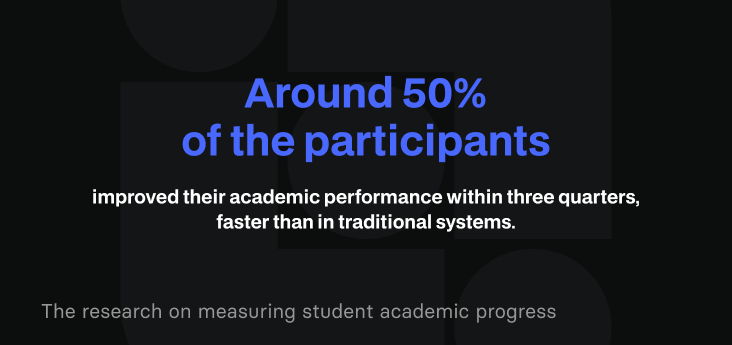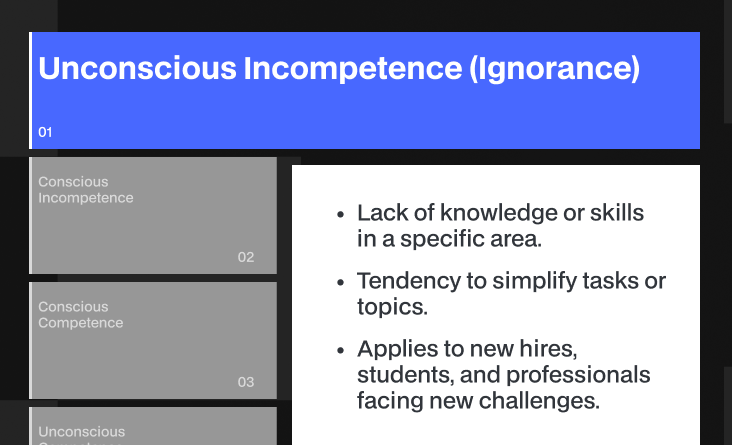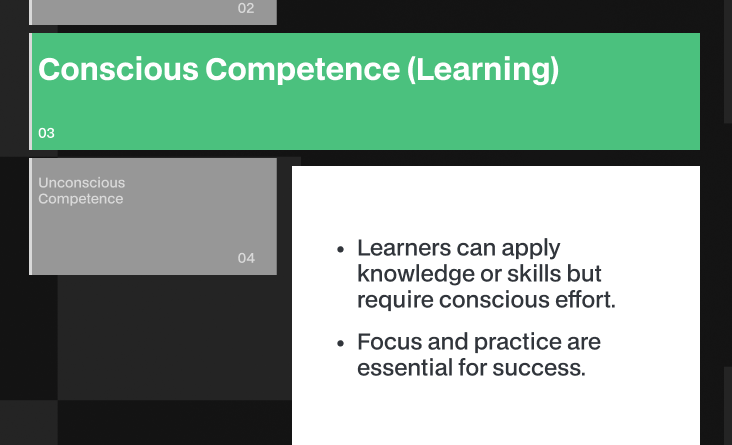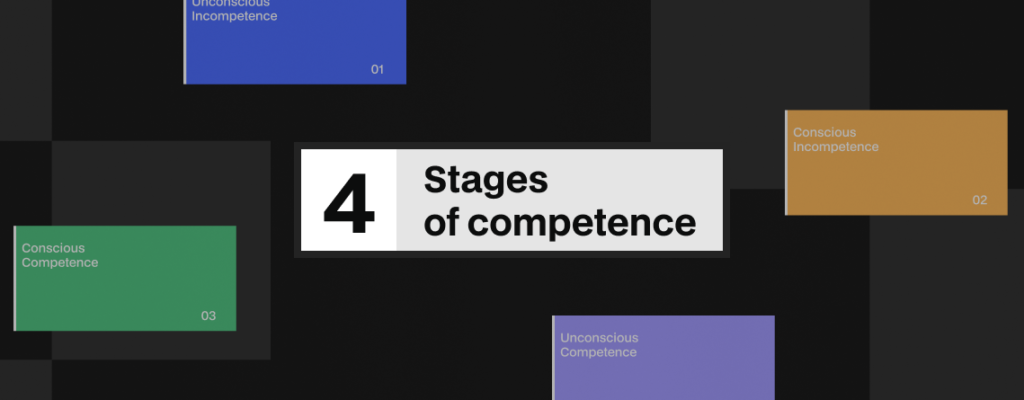Ever taken on the early stages of learning something new, only to go through it trying to find your footing? Maybe it was a foreign language, a musical instrument, or maybe a detailed software program. You may have felt confused, you may have felt mad, you may have even felt ashamed. This collective learning experience can be understood using a concept referred to as the Four Stages of Competence. It’s a kind of model through which we can see what it means to go from being a beginner to becoming an expert.
A deeper understanding of these stages will allow us to see the learning process in a little more detail, which helps us understand ourselves and others better. Most importantly, we can recognize the areas where we have to put the most effort to speed up our growth.
The stats show as proof, such as the 2016 Udemy Workplace Boredom Study, which indicates that eight out of 10 people thought they would be more engaged if they had the chance to learn new skills. With that in mind, let us take this journey together to cover the Four Stages of Competence. After reading our article, you will have a much better idea of how you learn and be better prepared to face new challenges.

What Are the Four Stages of Competence?
There has always been a dispute on the feasibility of introducing new competency-based learning while there is a well-established and time-tested traditional approach. The research on measuring student academic progress in a competency-based education system shows that around 50% of the participants who previously lagged a bit behind in academic performance achieved their performance levels within three or fewer quarters, faster than would be possible in a traditional education system.
The Four Stages of Competence Model was developed in the 1970s by Noel Burch. The model is a framework of the progression people make as they learn a new skill or area of knowledge. Today, the Noel Burch Four Stages of Competence are used across industries, including business, education, and personal development. Leading learners through 4 Learning Stages of Competence to reach their biggest potential to grow and develop a skill set.

Imagine you are struggling to learn a new dance move. You start clueless, not even knowing how to coordinate your feet and arms. This is the first of the Four Stages of Competence – Unconscious Incompetence.
Then, you start taking dance lessons, and you realize how much you don’t know. This is Conscious Incompetence. You’re aware of your skill gap and actively working to improve. It can be frustrating, but it’s a crucial step towards mastery.
With practice, you start to get the hang of the dance move. You can perform it, but it takes effort and concentration. This is Conscious Competence. You’re skilled, but you’re still thinking about every step.
Finally, after lots of practice, the dance moves become second nature. You can execute it effortlessly, without even thinking about it. This is Unconscious Competence – the last of 4 Stages of Competence. You’ve reached the pinnacle of skill mastery.
While the model suggests a clear, linear movement through the stages users may advance or regress through stages as they learn and acquire new capabilities. The time step level also changed according to the complexity of the skill and the learning strategy.
Stage 1: Unconscious Incompetence (Ignorance)
The first stage of the four-stage learning model is Unconscious Incompetence or simply put, “Ignorance”. At this stage, they would know or be learning that they have no knowledge or skills in the particular area. They can also tend to simplify a task or topic.
Examples:
Understandably, new hires in an organization or a specific role may be unfamiliar with aspects of company culture, software applications used internally, or nuances around industry-specific legislation; similarly, students studying a particular branch or subject for the first time may not know what prior knowledge or skills are required to succeed. This phase can affect even the most seasoned of professionals in the face of new technology or changing industry dynamics.
To effectively guide learners out of this initial stage, L&D professionals must employ a strategic approach that involves:
- Needs assessment, identifying knowledge gaps, determining learners’ current capabilities and their growth potential, and designing learning solutions.
- Proper roadmap, communication expectations, clear learning objectives, setting relevant and ABCD Model of Learning Objectives.
- Educational interactive experiences (simulation/case studies and role-playing, relevant to the real world timely feedback, and the opportunity for students to practice new skills in a safe environment).
If you effectively address the needs of the learners who are in the Unconscious Incompetence phase, you will be able to put them in the next phase which is the Conscious Incompetence phase where you can sensitize them toward their limitations and drive their potential to improve. Being able to see that is the first step in learning and growth.

Stage 2: Conscious Incompetence (Awareness)
The second stage is Consciously Incompetence in the four-stage learning model. In this stage, people are aware that they do not know or can not do something, however, they have no instructions on what to do about it yet. This awareness is a critical step in the journey because it is an acceptance of the need to re-learn and discover.
Examples:
A new employee probably knows that they are not familiar with the company policies, procedures, and industry standards. Maybe you are a manager asked to oversee a remote team for the first time and realize the new leadership skills you must develop.
As one of the key roles, the L&D professional helps learners navigate through the Conscious Incompetence stage. It can look different depending on the learner. Here are some strategies:
- Mentorship and coaching with one-on-one guidance, regular check-ins, feedback, and encouragement.
- Targeted skill-based training, needs assessments, and Learning in the Flow of Work (LIFOW).
- Supportive learning environments, safe non-judgmental spaces, fostering collaborative learning with access to relevant tools, technology, and information.
Knowing the challenges and opportunities of the Conscious Incompetence stage helps L&D professionals to help learners effectively on their path to mastery. Through tailored support, guidance, and resources, L&D can help learners face their novice nature and develop into confident and capable learners.

Stage 3: Conscious Competence (Learning)
Individuals in this stage of Conscious Competence are aware of their knowledge or skills and can apply them effectively. They understand the task or concept and can perform it with conscious effort.
Examples:
A new employee who has completed training and can now perform their tasks correctly, but still needs to focus on each step. Another example is a student who has learned a new mathematical concept and can solve problems using it but needs to concentrate on the process. Or a language learner who can form sentences and communicate basic ideas, but still needs to think about the grammar rules.
L&D plays a crucial role in supporting learners in this stage to move towards mastery. Here are some key strategies:
- Specialized training with a course, mentorship programs, and professional certifications.
- Performance coaching with feedback, check-in calls, frequent one-on-one meetings, and goals that are clear and attainable.
- Application to real projects, simulations, and sharing of ideas in a collaborative manner, in a supportive atmosphere.
The L&D purpose is to move the learners from Conscious Competence to Unconscious Competence (perform a subject without thinking). Given proper support and opportunities, L&D can be the accelerator of this learning journey.

Stage 4: Unconscious Competence (Mastery)
The final stage of the four-stage learning model is called “Mastery”, or Unconscious Competence. Here is where people have so absorbed a skill or body of knowledge that they can do it automatically and without even thinking about it. This is the “muscle memory” phase, where things happen subconsciously.
Examples:
A seasoned teacher delivers engaging lessons and adapts to different learning styles without conscious effort. Or a master musician plays an instrument with flawless technique and emotional expression.
While individuals at this stage may seem self-sufficient, L&D can still play a crucial role in maintaining and enhancing their competence. Here are some key strategies:
- Continuous learning opportunities (specialized courses or workshops to deepen expertise and explore new frontiers).
- Mentorship programs, industry conferences, and webinars.
- Knowledge sharing, collaboration in online or in-person communities of practice, and promoting cross-functional projects.
- Succession planning, identifying high-potential individuals, and career development plan creation.
With a focus on continuous learning, collaboration, and forward planning, the L&D is equipped at the Unconscious Competence level to push individuals beyond their best and towards a significant contribution to the organization.

Conclusion
The Four Stages of Learning are revolutionary for L&D. By identifying where learners are on their journey, you can ensure that your training programs follow suit. So, if they are in the stage of Unconscious Incompetence, you would focus your attention on awareness, and motivating them most likely. If they are in the Conscious Incompetence stage, you can offer them structured learning experiences and more supportive feedback. Provide opportunities for practice and refinement for those in Conscious Competence. These Four Stages of Competence examples enable us to better promote a culture of constant learning and development, ultimately allowing individuals to thrive and the organization to succeed.
By continuous learning, collaboration, and future focus, L&D can change Unconscious Competence into uncapped success and growth for individuals in a fast-paced market where companies are thriving.
FAQ
What are the Four Stages of Competence?
The Four Stages of Competence is a model that describes the journey individuals go through when acquiring a new skill or knowledge area. The four stages are:
- Unconscious Incompetence
- Conscious Incompetence
- Conscious Competence
- Unconscious Competence
Who developed the Four Stages of Competence?
The Four Stages of Competence model was created by management consultant Noel Burch in the 1970s.
